Zoos, aquaria, and natural history museums all showcase amazing biological diversity in their exhibits, but after years of visiting both kinds of institutions across the globe, I’ve noticed that zoos emphasize different messages than natural history museums. Natural history museums are great at telling the story of evolution, and explaining the science behind evolutionary biology, through exhibits based on palaeontology and biodiversity. Museums do a great job of explaining the role of extinction in shaping diversity in the past, and modern exhibit renewals are often doing a great job of linking changes in Earth’s history to the changes we see around us today.
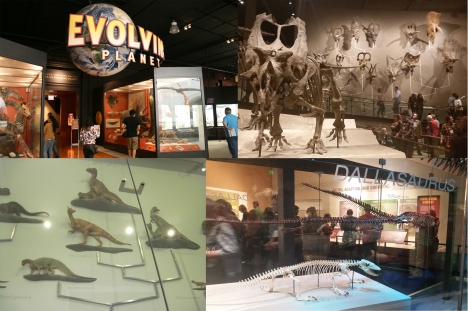
Evolution on exhibit at (clockwise from top left): the Field Museum, Utah Museum of Natural History, Perot Museum of Nature and Science, and the American Museum of Natural History.
Zoos and aquaria, on the other hand, tend to emphasize conservation as their primary message. Take a look at the information placards at zoos or aquaria and you’ll typically see information like the species name, geographic range, a couple of comments about diet or behaviour, and its conservation status, and many zoos will group animals that live in similar ecosystems together (think Amazonian rainforest, the poles, etc).
The Maui Ocean Center does a great job of grouping animals by ecosystems – it focuses on the sea life around Hawaii, and takes you through ever deeper zones of the coral reef and their changing fauna, out to the pelagic zone with sharks. (Also a bonus: a great exhibit on marine mammals which doesn’t involve keeping any in captivity!)
How and why did evolution and conservation become separated in zoos and museums? I don’t have an answer for that, but I’d love to see more evolutionary stories making their way into zoos. The evolutionary history of species, subspecies, and populations is increasingly important for identifying which populations need the most protection, and for making the best plans for successful conservation of species. We’re learning that not all populations are interchangeable even within one species, and framing species conservation priorities in terms of the loss of phylogenetic diversity can help motivate the protection of endangered populations.
A nod to evolutionary storytelling at the Toronto Zoo – African rift lake cichlids are a classic example of an adaptive radiation.
An example of an evolution-based mindset that I find compelling: Let’s say that we managed to lose the platypus and the four species of echidna. That’s five species, which isn’t very many species to lose. The platypus and echidnas all belong to a clade called Monotremata, which, along with their extinct relatives like Pseudotribos and Shuotherium, first diverged from the lineage leading to all other living mammals more than 220 million years ago. Living monotremes are really far away from placental mammals and marsupials on the evolutionary tree – placental mammals and marsupials are each others closest relatives (as clade Theria), but a whole bunch of other clades sit between Theria and the monotremes, all of them extinct: the extremely successful multituberculates, the dryolestoids and eutriconodonts, things like Fruitafossor and Volaticotherium. To lose just five species would be to lose a huge chunk of phylogenetic diversity and a deep branch of the tree of life. To lose any twig of the tree is heartbreaking; even more so to lose old giant branches.
On this evolutionary tree, humans, as placental mammals, are in the red branches, marsupials like kangaroos are in the blue branches, and monotremes are way down the tree on the green branch. No species from the yellow branches in between survive today. (From Luo 2007, Transformation and diversification in early mammal evolution, Nature 450.)
This isn’t a story that gets told very often, partly because we’re still learning so much about the evolution of mammals, partly because not many zoos have a platypus, and partly because it can require a lot of background information about evolutionary thinking that zoos might not have the space to teach. But there are many stories like this one, and I think these are compelling narratives for visitors to encounter at zoos. Zoos do a great job of explaining the ecological interconnectedness of animals, why not their evolutionary interconnectedness?
Here’s another example of an evolutionary story that zoos are well equipped to discuss, and I’ll use an example here because there is a GREAT example at the San Diego Zoo. Species loss and defaunation is a critical issue we’re currently facing, but what constitutes a ‘natural’ ecosystem, anyway? Even prior to European colonization, North America had a surprisingly depauperate fauna missing most of the megafauna that had existed up until about 10 000 years ago. Ten thousand years isn’t a very long time for animals to adapt to such a dramatic shift in their ecosystem, and so around us we see evidence for evolutionary ghosts. The incredible speed that pronghorns can achieve makes a bit more sense when you realize that North America used to have a cheetah. The weird, giant, and typically uneaten fruits of trees like the Osage orange, pawpaw, and honey locust make a bit more sense if you picture mammoths, gomphotheres, and ground sloths in the picture. And that brings us to the San Diego Zoo:
When you walk around to the back of the San Diego Zoo where the elephants hang out, you enter one of the best zoo exhibits around: Elephant Odyssey. This area links the fossils of the La Brea tar pits with the animals still living in southern California today. (There’s even a tar pit that ‘drains’ to reveal fossils, which sadly I did not photograph way back in 2009 when I visited.) This area has animals found in southern California today, like the California condor (itself an amazing ambassador for extinction and conservation) and pronghorn, living relatives of extinct species from the tar pits, like tapirs, camels, and jaguars, and life-size statues of extinct species like ground sloths and mammoths.
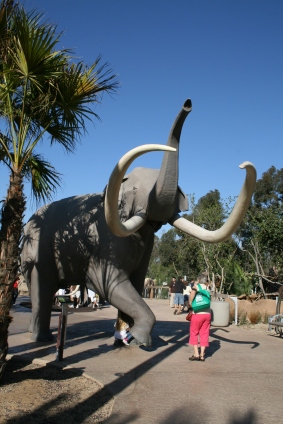
It’s an amazing exhibit that weaves together evolution, conservation, and biodiversity, all while getting to hang out with cool animals in a great setting. Bringing all of these large mammals together into one area highlights the diversity that has been lost from North America already, and hopefully inspires people to conserve the species that still call southern California home (like the condor! And don’t forget cougars, slowly making a return!).
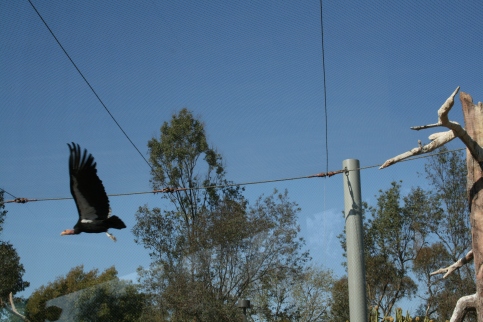
Condor!
So, those are two approaches to evolution at the zoo that I’ve come up with: using the interconnectedness of species through their evolutionary histories, and using stories of extinction, to emphasize conservation priorities. Have you got any examples of zoos or aquaria that incorporate evolution into their interpretive materials? I’d love to hear about them, so please share them below in the comments!
This post was inspired by conversations at a discussion group I attended at the University of Toronto last week, where we talked about the role of natural history museums, zoos, and aquaria in conservation biology. There’s definitely lots to think about on this topic and I’m sure it’s one I’ll revisit in the future!
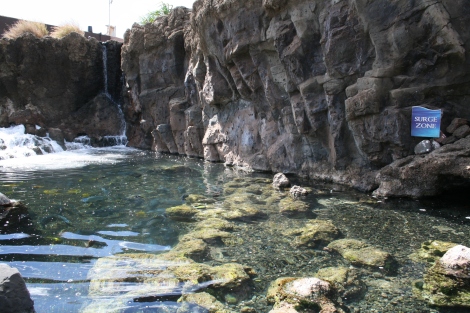
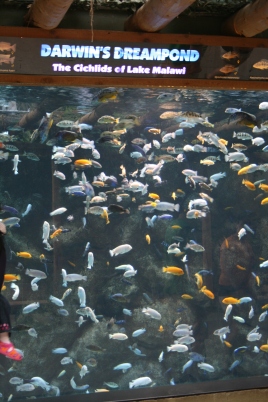
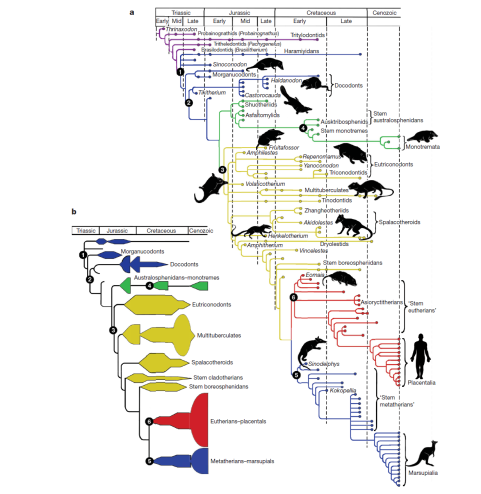
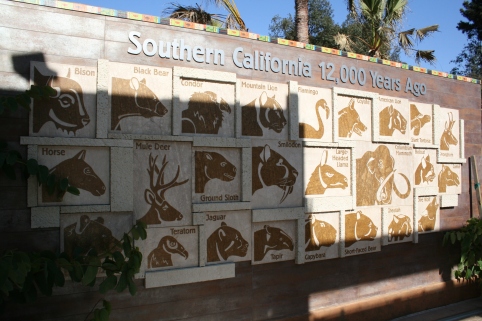
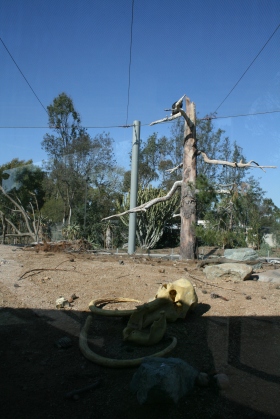
The Arizona-Sonoran Desert Museum (which, despite its name, is primarily a zoo/arboretum) has a display of the origin of birds and of avian flight on the outside of their Bird Hall. The exhibit design is a generalized phylogeny (done as a tree) with brass models of the different phases from vertebrate history on the line to modern birds.
LikeLiked by 1 person
Great article! The Lobbecke Museum + Aquazoo in Germany is, as its name suggests, a combination aquarium and natural history museum. But the two don’t just share the same roof — they are fully integrated with one another. So you have things like an interpretive display showing the different ways that fish swim, with tanks showing live examples of each. Or most relevant to this article, fossils displayed right beside tanks containing their living relatives. It’s a great approach that I wish was seen more often!
LikeLiked by 1 person
Elephant Odyssey is amazing! Far and away one of my all-time favorite zoo exhibits that I’ve seen. Long before that exhibit was put in (apparently before 1997!) I remember seeing a Sumatran rhino at the SD Zoo. The signage took advantage of its wooly appearance and used the opportunity to talk about rhinoceros evolution, depicting several extinct taxa in scale with each other. I remember this being the first time I was made aware of indricotheres, which I immediately fell in love with, but sunsequently failed to find any information about for the next several years at my local library.
Sea World San Diego also had a really cool shark encounter that made a big deal about their deep evolutionary history; I last visited as a little kid, so I don’t remember whether it amounted to anything more than scenery (shark teeth and fossils in the faux rock walls, and a Megalodon jaw near the shark tunnel), but it still at least got visitors contemplating deep time.
LikeLike
I can also vouch for the greatness of Elephant Odyssey.
I’ve thought for some time that a phylogenetically-arranged zoo would be quite interesting (one obvious drawback being that it would be extremely difficult to keep up to date if it goes too deep).
LikeLike
Pingback: Evolution at the Zoo: Prehistoric Park Edition | pseudoplocephalus
I know this is an old post, but there’s the Ancient Fishes exhibit in the New England Aquarium’s Thinking Gallery.: http://galleries.neaq.org/2011/07/walking-back-through-time-ancient.html
LikeLike